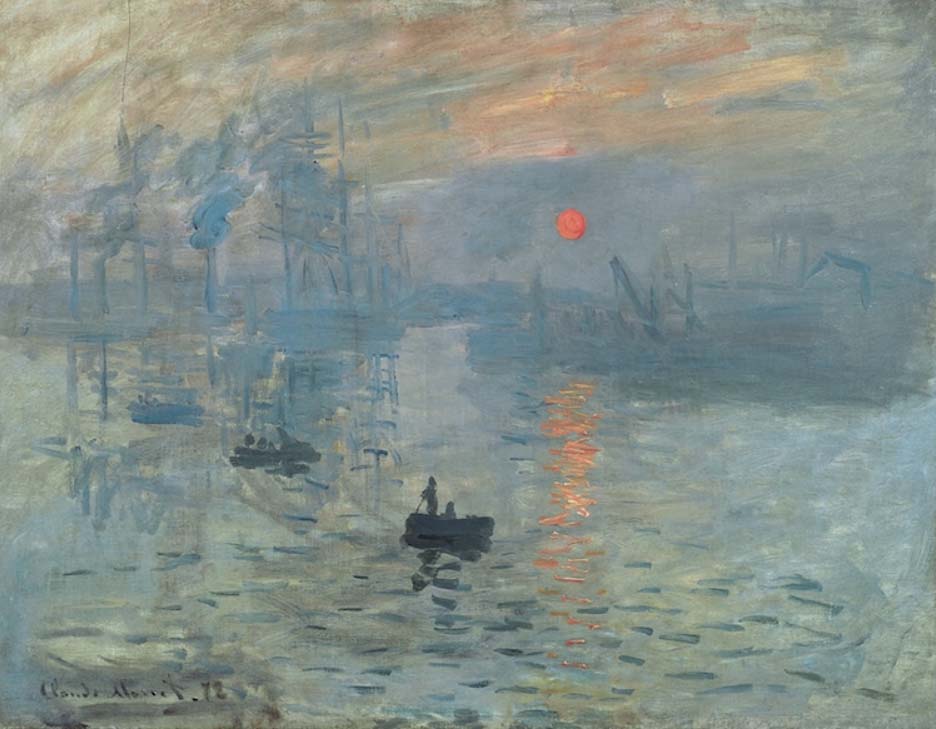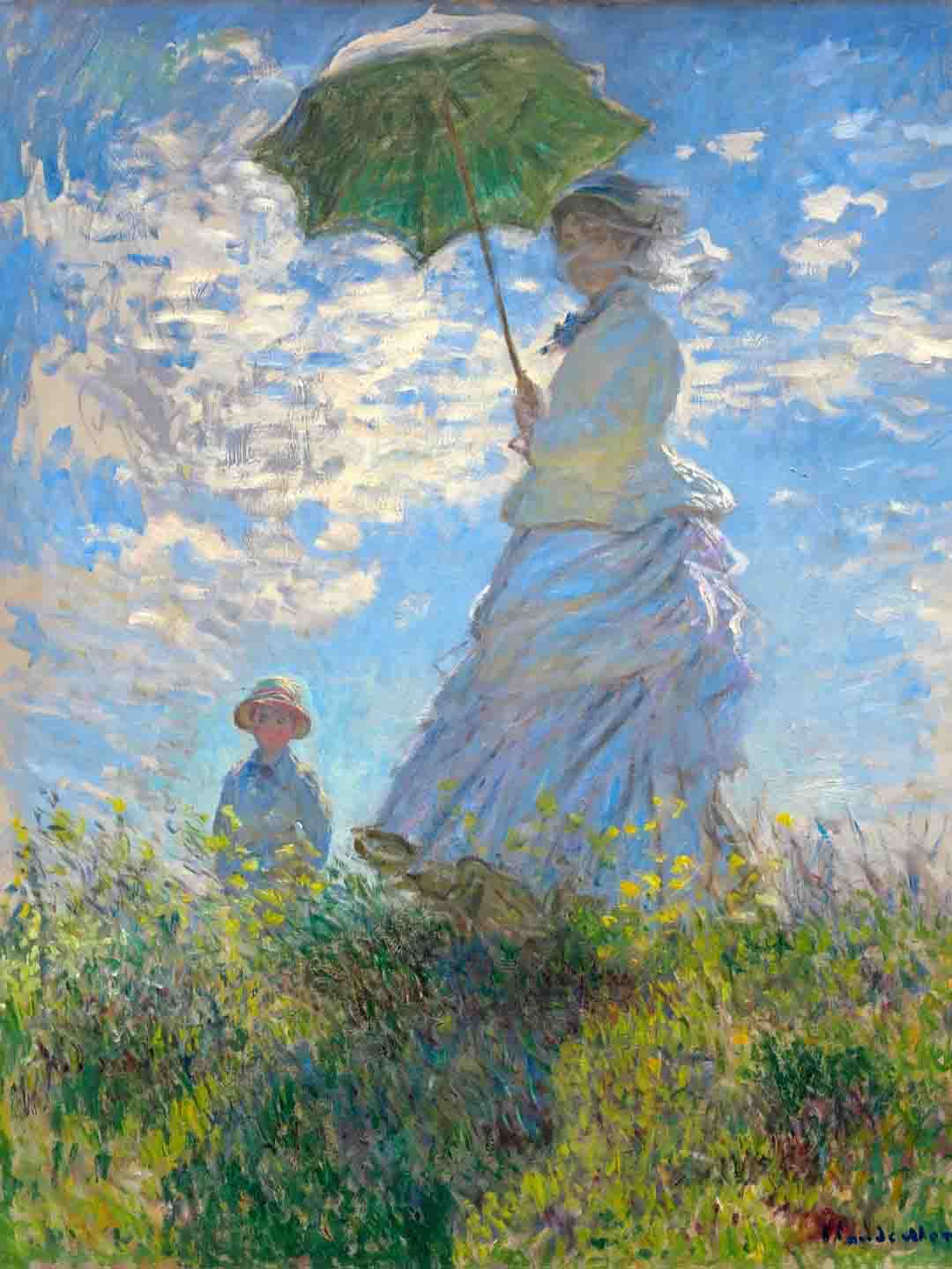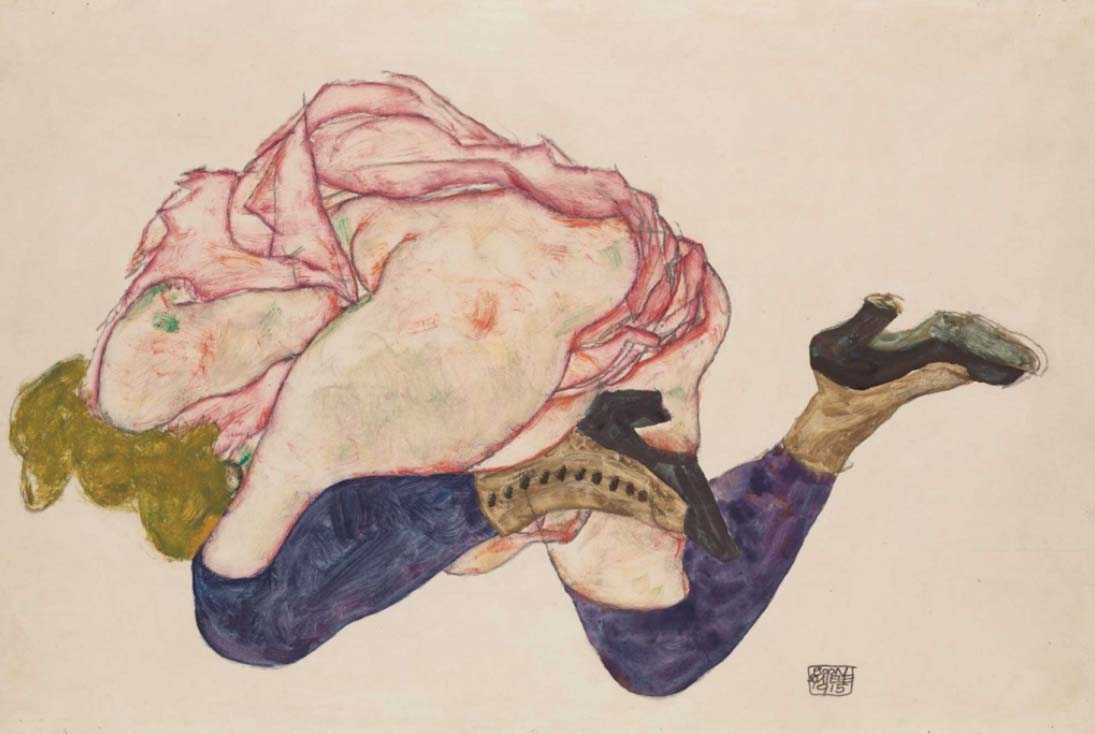Impressionism emerged in France during the late 19th century and became a revolutionary art movement that challenged traditional academic painting. The term "Impressionism" was coined by the French critic Louis Leroy after viewing Claude Monet’s painting Impression, Sunrise in 1874 at the Salon des Refusés. Instead of focusing on historical or mythological subjects, Impressionist artists sought to capture fleeting moments, the effects of light, and the changing atmosphere of everyday life. They emphasized painting en plein air (outdoors) and used quick, visible brushstrokes to render the sensation of movement and immediacy. Notable figures include Claude Monet, Pierre-Auguste Renoir, Edgar Degas, and Camille Pissarro.
Monet’s Woman with a Parasol is a prime example of Impressionism. Painted in 1875, the work captures his wife Camille and their son Jean in a spontaneous outdoor setting. The loose brushwork, vivid colors, and shifting light create an impression of a breezy summer day rather than a static portrait. This emphasis on perception over detail lies at the heart of the Impressionist style. In summary, Impressionism is defined by its focus on light, color, and fleeting moments captured with immediacy and vitality.

Expressionism developed in Germany and Northern Europe at the turn of the 20th century. Rather than depicting external reality, Expressionist artists sought to convey inner emotions, anxiety, and psychological states through distortion, exaggeration, and bold use of color. Unlike Impressionism, which celebrates the visual impression of a moment, Expressionism reveals subjective truth and personal experience. The term gained prominence through groups such as Die Brücke (founded in Dresden in 1905) and Der Blaue Reiter (formed in Munich in 1911). Artists like Edvard Munch, Wassily Kandinsky, and Ernst Ludwig Kirchner became central figures of the movement.
Munch’s The Scream, painted in 1893, epitomizes Expressionism. The swirling sky, distorted figure, and unsettling palette evoke existential dread and emotional turmoil. Unlike Monet’s luminous portrayal of serenity, Munch’s canvas embodies raw inner anguish. Expressionism is therefore defined by its emphasis on emotion, psychological intensity, and symbolic distortion of reality.

The primary difference between Impressionism and Expressionism lies in their approach to reality and perception. Impressionism seeks to depict the external world as it appears in a specific moment, focusing on light and atmosphere. Expressionism, on the other hand, rejects objective representation and channels inner emotions through distortion and symbolism. Monet’s soft, natural tones celebrate life’s fleeting beauty, while Munch’s bold, warped forms reveal existential fears. In essence, Impressionism captures external impressions, while Expressionism exposes internal emotions.

Impressionism’s most notable figures include Claude Monet, Pierre-Auguste Renoir, and Edgar Degas, whose works highlighted leisure, urban scenes, and natural landscapes. Expressionism’s leading figures include Edvard Munch, Wassily Kandinsky, and Egon Schiele, whose works explored anxiety, spirituality, and human vulnerability. Each movement reflected the social and cultural environment of its time: Impressionism mirrored industrial modernity and urban change, while Expressionism resonated with the psychological unrest of the early 20th century. Both movements transformed modern art, but they did so by emphasizing different aspects of human experience.

Impressionism and Expressionism represent two distinct yet influential approaches to modern art. While Impressionism conveys fleeting external impressions of reality, Expressionism reveals deep inner truths through emotional distortion. Both movements expanded the possibilities of painting and paved the way for future innovations in modern art. Ultimately, Impressionism highlights perception, and Expressionism emphasizes emotion, together shaping the evolution of modern artistic expression.
Hi, I’m Philo, a Chinese artist passionate about blending traditional Asian art with contemporary expressions. Through Artphiloso, my artist website, I share my journey and creations—from figurative painting and figure painting to floral oil painting and painting on landscape. You'll also find ideas for home decorating with paint and more.

Impressionism captures fleeting moments of light and color in the external world, while Expressionism distorts reality to express inner emotions and psychological states.
The French critic Louis Leroy coined the term in 1874 after viewing Claude Monet’s painting Impression, Sunrise at the Salon des Refusés.
Expressionism developed in Germany around 1905, with groups like Die Brücke and Der Blaue Reiter leading the movement.
No. The Scream by Edvard Munch is an Expressionist work that emphasizes emotional intensity rather than visual impression.
Impressionist works, with their light colors and open compositions, work well in naturally lit spaces. Expressionist works, with their intense colors and dramatic forms, create striking focal points in quieter or more intimate settings.
Simple, light-toned frames complement the airy brushwork of Impressionist art. Expressionist works often benefit from darker, bolder frames that echo their intensity.
Key Impressionist collections are housed in the Musée d’Orsay in Paris and the Metropolitan Museum of Art in New York. Important Expressionist works can be found in the Munch Museum in Oslo and the Neue Galerie in Berlin.
Yes, but balance is important. Impressionist works bring lightness, while Expressionist pieces add depth and drama. A combination can create dynamic visual contrast when thoughtfully arranged.
